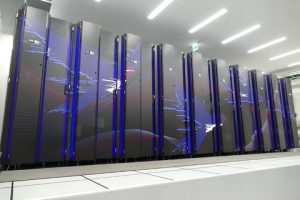TOKYO, June 26, 2024 — The Global Scientific Information and Computing Center (GSIC) of the Tokyo Institute of Technology (Tokyo Tech) is developing a next-generation supercomputer, Tsubame 4.0April 1st.
 Since TSUBAME 1.0 went live in April 2006, the Tokyo Institute of Technology’s TSUBAME series of supercomputers has supported research and development in industry, academia, and government both in Japan and overseas for many years as a “supercomputer for everyone.”
Since TSUBAME 1.0 went live in April 2006, the Tokyo Institute of Technology’s TSUBAME series of supercomputers has supported research and development in industry, academia, and government both in Japan and overseas for many years as a “supercomputer for everyone.”
The latest system, “TSUBAME4.0,” currently in operation at the Suzukakedai Campus, proactively utilizes GPUs, a feature of the TSUBAME series, to achieve 5.5 to 20 times the performance improvement and ease of use while maintaining continuity with the TSUBAME3.0 system.
Also, for the first time in the TSUBAME series, we invited public submissions for the rack design. Inspired by the various possibilities and uses of the new supercomputer, the design depicts four swallows with their wings spread out into an infinite world, with freely flowing lines.
The TSUBAME series is open to researchers not only within the university, but also to researchers outside the university and from companies through joint-use systems such as the Joint Usage and Research Center for Interdisciplinary Large-Scale Information Infrastructure (JHPCN) and the Innovative High Performance Computing Infrastructure (HPCI). The aim is for the TSUBAME series to continue to be “everyone’s supercomputer,” with the aim of being used on a daily basis.
TSUBAME4.0 boasts a high performance of 952 petaflops in 64-bit double-precision calculations, which are mainly used in scientific and technological calculations, and 16-bit half-precision calculations, which are used in AI, etc. This makes it the second largest supercomputer in Japan, second only to “Fugaku,” among the existing supercomputers at research and educational institutions.
TSUBAME4.0 Configuration
|
Number of computing nodes/units |
240 HPE Cray XD665 |
|---|---|
|
AMD EPYC 9654 (96 cores) x 2 |
|
|
NVIDIA H100 SXM5 94GB HBM2e x 4 |
|
|
InfiniBand NDR200 200Gb x 4 |
|
|
HPE Cray Cluster Storage E1000 |
TSUBAME4.0 system performance
|
Overall Computing Performance |
|
|---|---|
|
66.8 petaflops (5.5 times that of TSUBAME3.0) |
|
|
952 petaflops (20 times that of TSUBAME 3.0) |
|
|
Hard disk: 44.2PB (2.8 times that of TSUBAME3.0) |
To commemorate the start of operations, GSIC held a TSUBAME 4.0 unveiling ceremony and tour at its Suzukakedai Campus on April 18, welcoming approximately 100 visitors.
The ceremony began with opening remarks by GSIC Director Toshiya Ito, followed by congratulatory speeches from guests. Following an overview of TSUBAME4.0 by GSIC Professor Toshio Endo, two academic lectures were given: “Trends in mid-molecule drug discovery accelerated by supercomputers” by Professor Yutaka Akiyama of the School of Computing, and “Large-scale language model Swallow by Tokyo Institute of Technology and the National Institute of Advanced Industrial Science and Technology” by Professor Rio Yokota of GSIC. The lectures introduced cutting-edge research realized on the TSUBAME series and expressed hopes for a significant acceleration of research using TSUBAME4.0.
Regarding the merger of Tokyo Institute of Technology and Tokyo Medical and Dental University to form Tokyo University of Science (Science Tokyo) in October this year, President Kazuya Masu said, “TSUBAME 4.0 will play an important role not only in Tokyo Institute of Technology’s existing research, such as meteorology, physical science, materials science, computational chemistry, image processing, language processing, and artificial intelligence processing, but also in the development of academic fields such as AI, medical and dental sciences, and geological environmental sciences.”
TSUBAME 4.0 will contribute as an essential computing resource infrastructure for the “development of integrated science” that Science Tokyo aims to achieve.
For information on the main programs of TSUBAME4.0 and how to apply for an account, How to apply for a TSUBAME account Please see the page. For information on fees, please see here.
Source: Tokyo Institute of Technology

